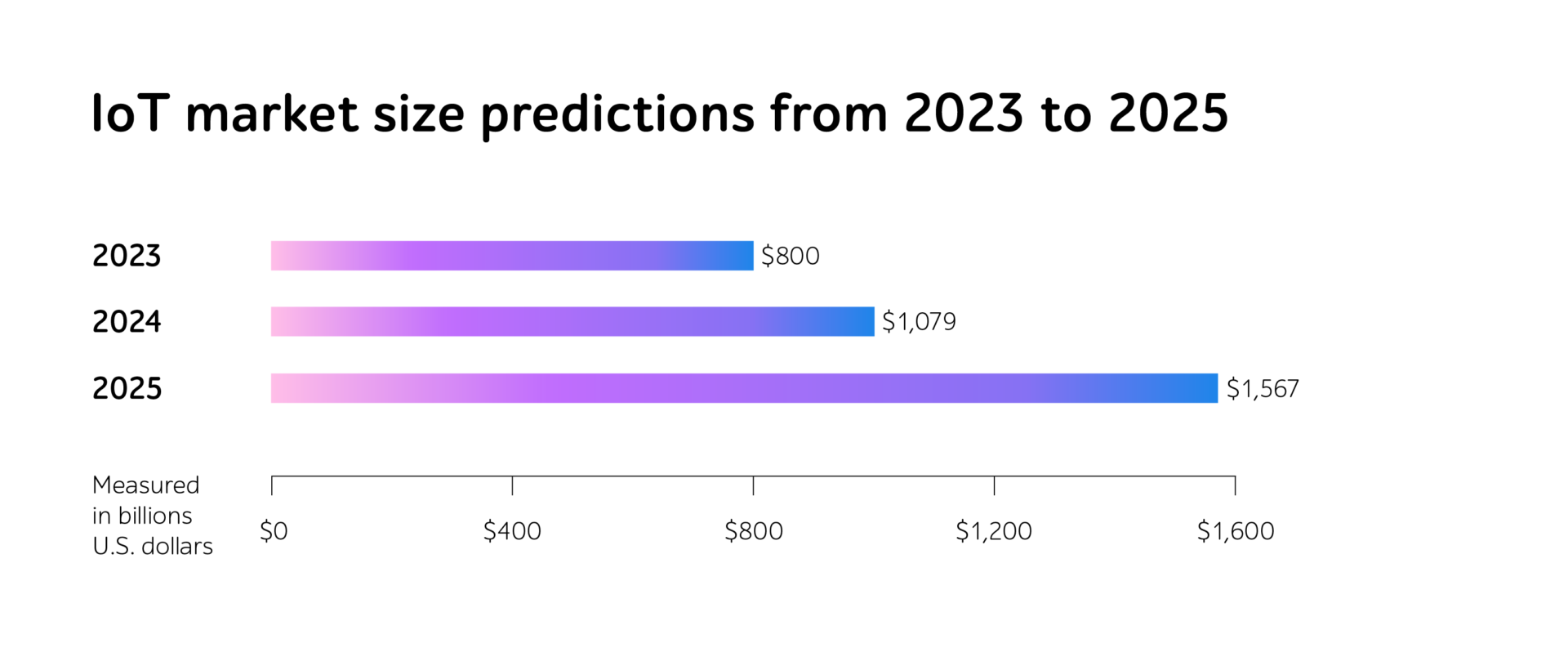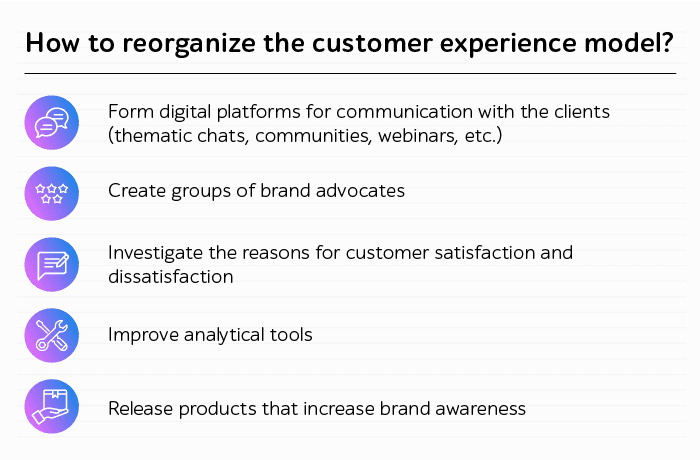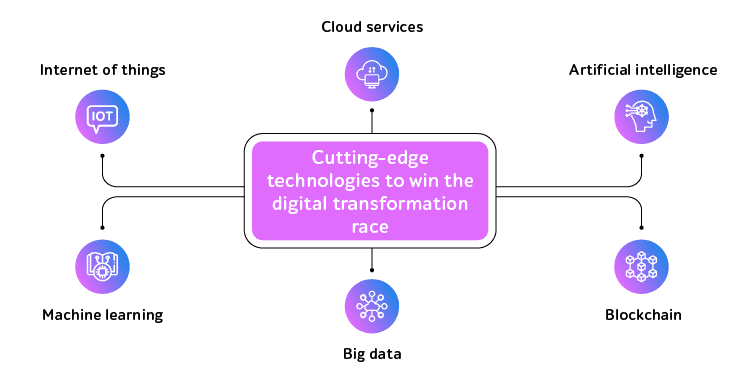Say your favorite song out loud, and it immediately starts playing. Of course, if you have an Alexa speaker. Imagine Alexa crashing from time to time. A bit annoying, but still, not the worst outcome.
The failure of a smart inhaler or a sensor or the leakage of patients’ medical data are much more serious issues, making companies focus on ensuring quality of various aspects of IoT devices.
Whether it’s a smart speaker, a car, or a factory, absolutely every IoT solution should function steadily to provide a positive experience to end users. And to achieve this target, businesses should carefully plan their IoT application testing strategies.
In the article I’ll tell you how IoT affects our lives and what quality aspects are key to verify and why.
IoT impact on people’s lives
According to Statista, the IoT market size will reach $800 billion in 2023 and $1,567 billion in 2025. A very considerable growth.

Source: Statista
Nowadays, IoT is used in multiple industries where the smallest software error results in dire consequences. For example, delivering real-time data from the Internet of Medical Things (IoMT): wearable and other devices that track physical activities, sleep, heart rate, and more. This information enables carrying out diagnostics, planning treatment, and helping provide medical care when needed. Imagine a patient in critical condition but not getting medical support in time because of a glitch in the IoMT.
Or government organizations that also deploy IoT technologies to address various challenges (e.g., traffic jams or street light control). Along with that, IoT sensors embedded in urban infrastructure help create smart cities. This means that the safety and lives of millions and even billions of people depend on the trouble-free functioning of IoT products.
And now I will show you some examples that you shouldn’t turn a blind eye to if your main goal is to provide superior quality of your IoT solutions.
IoT solutions cybersecurity: always be on the lookout
Problem overview
In 2021, the number of connected IoT devices was 12.2 billion, and is projected to reach 24.4 billion in 2024.
As the number of linked software grows and the IoT solution elements can exchange information without human intervention, all of these significantly reduce system security. Moreover, today’s IoT devices collect massive volumes of end-user data: passwords and usernames, contact details, biographical and medical information. This means that companies should provide reliable and high-quality protection not only for the product itself but also for individuals’ sensitive data and the network which transmits personal details.
Let’s look at an example of how hazardous IoT devices are in the hackers’ hands. In 2017, more than 465,000 implantable pacemakers produced by St. Jude Medical had become fragile. The company quickly responded to the situation and addressed the issues. But what consequences it could encounter if the attackers gained full access to the IoMT solutions? By controlling the software and its functions (e.g., battery and heart rate), they could have damaged the lives of thousands of people. And this is pretty alarming.
Addressing the problem
Conducting cybersecurity testing is the remedy to this issue, helping ensure the safety of the whole system at all levels: network, cloud, applications, etc.
Penetration testing allows performing real-life attacks by imitating the cybercriminals’ actions. For IoT products, it’s also reasonable to carry out network penetration tests ― adopting malicious methods to reveal the network’s loopholes and eliminate them from the get-go.
To detect IoT system drawbacks, you may start with a vulnerability assessment of the solution. Checking authentication, authorization, session, multiple injections, and business logic allows ensuring a high-quality and secure IoT web device. For connected mobile apps, it’s necessary to evaluate configurations, traffic interception as well as review the source code and analyze encryption algorithms to detect any keys, logins, or passwords right in the code.
Why is IoT devices performance in the forefront?
Problem overview
Let’s take a look at one example to understand the importance of uninterrupted performance for IoT solutions. IoT in retail helps control the amount of goods on store shelves and warehouses — when needed, smart racks or fridges send a signal to refill the inventory.
Imagine a smart shop. Special RFID (Radio Frequency Identification) tags that are attached to the items allow transmitting the data to the cloud and monitoring the inventory and purchases. However, low performance of IoT devices in retail leads to the failure of the entire chain of stores and requires more investment, time, and efforts to recover the system’s smooth functioning.
Addressing the problem
The key question is: how to produce high-performance IoT products? These are 4 tips that will be of help:
- Integrating performance testing into the SDLC stages. Continuous performance testing guarantees that any changes to the code don’t negatively impact the app’s operation.
- Conducting load tests. They help measure app performance under specific conditions and determine the maximum load that the software and infrastructure can handle.
- Performing stress checks. If the load on web and mobile products doesn’t jump frequently (usually it happens during peak sales periods), forecasting either hundreds or thousands of people may connect to an IoT device is challenging. Stress testing helps assess the behavior of an IoT solution when the load is much heavier than regular.
- Verifying IoT’s scalability. The scalability of IoT devices depends on the number of connected software: some support more than a million solutions, others — a hundred million. Here, the main goal is to check whether the IoT product handles the required level of scalability and how it responds to changes in the number of simultaneous users.
IoT compatibility: do all elements work in harmony?
Problem overview
You have a pellet grill and the software to control it remotely: choose a recipe, set the temperature, and monitor the cooking process from your mobile app. On a Friday night, a pop-up window comes up on your phone “Please select the network,” even though it’s already running. It keeps repeating, which bothers you from a great dinner.
Let’s also look at it from the developers’ perspective. Do you know which browsers and OSs the end users are going to use? It’s hard to predict among the variety of devices. In 2021, 64% of people preferred Google Chrome over other internet browsers while 19% chose Safari. It’s hard to please everyone but businesses do their best to provide the majority of the target audience with a high-quality product that brings the ultimate experience.
Addressing the problem
So, what can help here? Compatibility testing is what companies need to ensure that IoT solution elements (platforms, networks, apps, etc.) work in tandem and make sure that the device is interoperable with multiple smartphone versions, operating systems, browsers, screen sizes and resolutions, networks, connectivity protocols, and more.
To provide seamless compatibility, companies may follow 4 main steps: analyzing business requirements and defining the target audience, choosing a testing strategy and designing tests, executing them to identify the system drawbacks, and providing recommendations on how to eliminate bugs.
Final thought
I know for sure IoT devices have made people’s lives much easier: smart homes, smart cities, smart factories — isn’t that a dream?
Due to their complexity, it’s critical to care about IoT solutions quality with great emphasis on cybersecurity, performance, and compatibility.
Don’t miss the opportunity to reach out to a1qa’s experts to ensure high quality of your IoT solutions.



